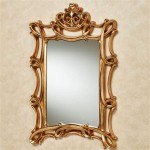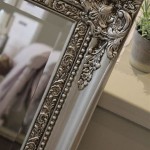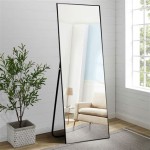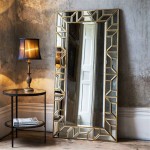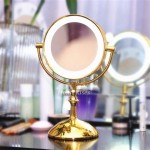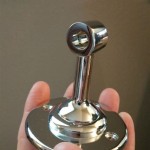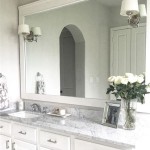How High Should Your Bathroom Mirror Be?
Determining the ideal height for a bathroom mirror involves considering several factors, including the height of the individuals using the space, the size of the mirror, and the height of the vanity. A properly hung mirror ensures functionality and enhances the overall aesthetic of the bathroom.
Standard Height Recommendations
While personal preferences play a significant role, industry standards offer a general guideline. A common recommendation is to position the center of the mirror approximately 58 to 60 inches from the floor. This measurement provides a comfortable viewing height for individuals of average height. However, this is a general guideline and should be adjusted based on individual needs and the specific dimensions of the bathroom.
Considering User Height
The most critical factor in determining mirror height is the height of the people who will be using it. For households with varying heights, finding a compromise is key. Consider the average eye level of the users and aim for the center of the mirror to be slightly above that point. This allows for comfortable viewing without excessive bending or straining.
Accounting for Mirror Size
The size of the mirror also influences the ideal hanging height. Larger mirrors naturally require a slightly lower placement to maintain proper proportions and allow for a full-body view. Smaller mirrors, such as those used above a pedestal sink, can be hung slightly higher. The goal is to maintain balance and ensure the mirror complements the overall bathroom design.
Vanity Height Considerations
The height of the vanity is another crucial element. Ideally, there should be a small gap, typically 2-4 inches, between the bottom edge of the mirror and the top of the backsplash or vanity countertop. This gap prevents splashing and creates visual separation between the two elements. For vanities with non-standard heights, the mirror height should be adjusted accordingly to maintain this separation.
Lighting and Reflection
The placement of the mirror should also take lighting into account. Ensure the mirror reflects the light effectively to illuminate the face and surrounding area. Avoid positioning the mirror where light fixtures or window frames obstruct the reflection. Proper lighting enhances visibility and creates a more functional and pleasant bathroom experience.
Accessibility and Universal Design
For bathrooms designed for accessibility, universal design principles should be applied. This involves considering the needs of individuals with disabilities, such as those using wheelchairs. Mirrors should be hung at a height that accommodates seated users, allowing for clear visibility. This often necessitates a lower placement than standard recommendations.
Aesthetic Considerations
Beyond functionality, the mirror's placement can significantly impact the overall aesthetic of the bathroom. A well-placed mirror can visually expand the space and create a sense of balance. Consider the surrounding elements, such as wall decor, lighting fixtures, and the overall style of the bathroom, when determining the final height. The mirror should seamlessly integrate with the existing design elements.

Bathroom Mirror Size Calculator

Bathroom Mirror Size Calculator

How To Choose The Best Size Mirror Olde Good Things

How High To Place Your Bathroom Fixtures Inspired Style

How High To Place Your Bathroom Fixtures Inspired Style

Guide To Hanging Bathroom Vanity Lighting And Mirrors Liven Design

How High To Place Your Bathroom Fixtures Inspired Style

How High To Place Your Bathroom Fixtures Inspired Style

What Is The Right Height For Sink Mirror Other Bathroom Fixtures

What S The Perfect Height For Hanging Your Bathroom Mirror Jottai

